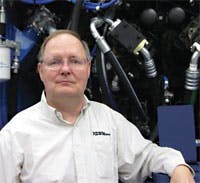editor
[email protected]
After my father in-law passed away, my wife and I went through the houseful of stuff he left behind. Many of the items were quite old because he held onto some of his father’s belongings. One of the many intriguing items was a collection of more than 300 music rolls for a player piano. I thought it might have been a real financial find but found out that rolls in good condition might be worth a few bucks apiece, and most of these were in fair condition at best.
Original player pianos work by using vacuum. The user sits in front of the piano and works a pair of pedals that drives a bellows type vacuum pump. A vacuum motor drives a takeup reel to pull the paper from the music roll. Vacuum also works actuators assigned to each piano key. Every note of the musical score is represented as a small hole on the roll, successively from left to right. As holes in the paper pass over corresponding holes in a tracker bar, corresponding notes are struck. This is digital music via pneumatic logic in its purest form — a hole is either present or not. The distance from the edge of the paper determines which note is struck, and the distance from the start point determines when it is struck.
My research led to a website for Warren Trachtman, a musician and engineer who (among other things) creates digital music files by scanning piano rolls. Placing a light behind the roll and drawing it through an optical scanner at a controlled speed creates a file of bits based on light, rather than vacuum. Warren then converts these bits into a .midi file that reproduces music recorded roughly 100 years ago.
I contacted Warren and eventually sent him rolls of some of my favorite songs from the collection to scan. He posted them to his website, and now they’re part of my iTunes library. Warren said that some recording pianos could even read positions of foot pedals for recording an artist’s individual performance.
To learn more, and to listen to some of Warren’s .midi files, go to www.trachtman.org. And for details about the workings of player pianos, go to www.pianola.com/ppworks.htm.


